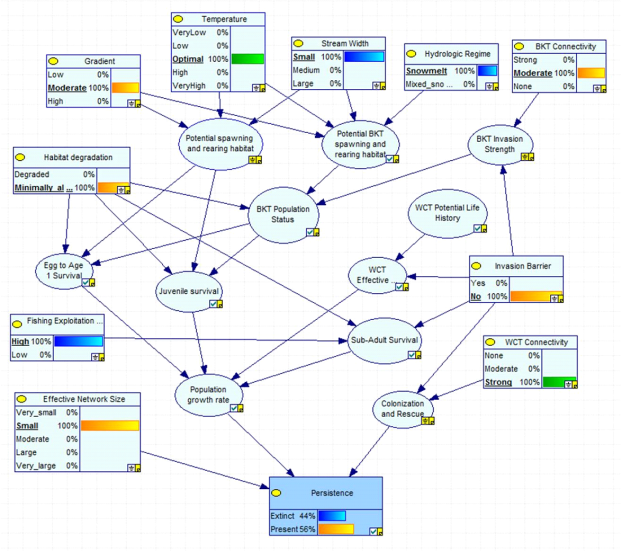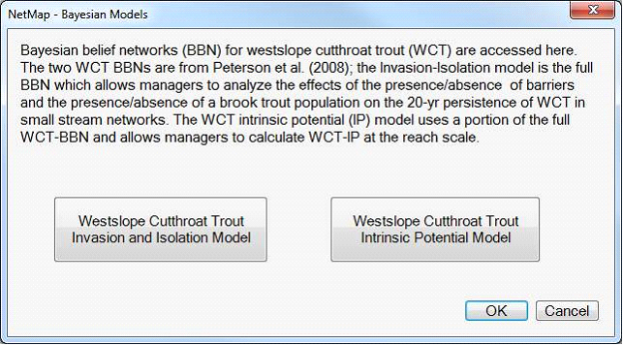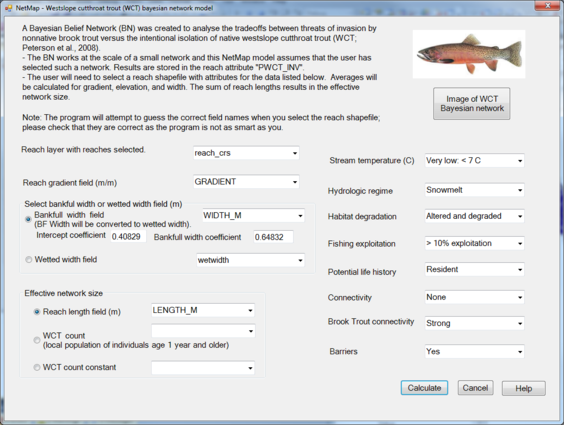| < Previous page | Next page > |
Model #1 Full BBNModel #1 (Full BBN)
Declines in native fish populations such as westslope cutthroat trout (WCT) are generally due to habitat fragmentation, the presence of anthropogenic barriers, as well as nonnative species (Rieman et al., 2003; Fausch et al., 2006). A Bayesian belief network (BBN) was developed to analyze the trade-offs between threats of invasion by nonnative brook trout and isolation of native WCT populations (Peterson et al., 2008). The BBN accounts for physical habitat quality and size of streams, interactions between the two trout species, and the effects of barriers on isolated populations, The BBN functions at the stream network scale using averages of environmental variables and results in the probabilities of a 20-yr persistent population of WCT being present or extinct in the selected stream network (Figure 1).
 Figure 1. Bayesian network to calculate the trade-offs between threats of invasion by non-native brook trout (BKT) and intentional isolation for native westslope cutthroat trout (Peterson et al. 2008).
The WCT BBN is implemented in the NetMap Habitat Add In under Bayesian Models \WCT Invasion-Isolation model (Figures 2 a and b).
(a)
 (b)
 Figure 2. NetMap Aquatic Habitat Menu showing (a) the Habitat Models menu and (b) the Bayesian Networks window.
The WCT BBN has 11 inputs and the user selects the reaches that comprise a small stream network with attributes for reach gradient (m/m), stream width (m) and reach length (m) (Figures 1 and 3). The WCT BBN uses wetted width as input, but the user can select an attribute for bankfull width or wetted width. If bankfull width is selected, it will need to be converted to wetted width. A linear regression equation (R2 = 0.61; p = 2.20E-16) to convert bankfull to wetted width was developed for stream reaches surveyed by the Kalispel Tribe Initiative (KTI).
The KTI stream width equation is the default but model users can supply an intercept and coefficient that fit their data. The model determines the effective network size in three ways: by using the reach length field to calculate the sum of total network length; by using the count of WCT in the stream network from a reach attribute; or by using a constant state count of WCT from the dropdown list. The model assumes that the user has selected a stream network and not disconnected reaches –this is not checked! Note that a network will be selected if NetMap reaches and the NetMap Habitat Models \Select Reaches tool are used.
Inputs on the right side of the user interface window all provide constant states which are selectable by the user from the drop-down boxes (Figure 3). The list of states for each input is determined by the authors of the WCT BBN and a description of each is found in Table 1 below and in Peterson et al. (2008) with more development details in the supplements.
 Figure 3. User interface for the NetMap westslope cutthroat trout invasion-isolation Bayesian network model.
The WCT BBN stores the result, which is the probability of a WCT population being present and persisting for 20 years, in the reach attribute “PWCT_INV”; this attribute is automatically mapped after calculations are complete. Note that there is only one average value for each stream network. The entire reach shapefile will be mapped so if you have completed several runs of the WCT BBN in different locations, all values will be shown.
Table 1.Node definitions and states for the isolation and invasion analysis and decision Bayesianbelief network (Source: Peterson et al., 2008). BKT = non native Brook Trout
Note: Nodes that refer specifically to brook trout (BKT, Salvelinus fontinalis) population ecology are so noted (e.g., potential BKT spawning and rearing habitat, BKT invasion strength). Nodes without a species designation refer either specifically to westslope cutthroat trout (WCT, Oncorhynchus clarkii lewisi) population ecology (e.g., fishing exploitation, potential spawning and rearing habitat, juvenile survival, persistence) or variables with a common influence on both species (e.g., temperature, habitat degradation, etc.). Details regarding definition of the nodes and information used to develop the associated conditional probability tables are in Supplemental Appendix S14. ainput nodes (I) are those where the BBN user designates the prior probability of being in a particular state. b “Effective network size” can be expressed as either length (km) of connected spawning and rearing habitat in a local stream network or the population size of individuals age 1 and older (age 1+) within the stream network.
|